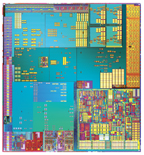Tuesday, January 27th, 2009
After the 1st “act” of the story of Intel as a memory chip company founded in 1969, the 2nd act really started in 1985 with the decision to bet the company on the 80386 microprocessor according to Richard S. Tedlow, Harvard Business School professor and residential scholar of the Computer History Museum, in a lecture yesterday. The company has been trying to start a 3rd act for some years now, and has decided that independent director Jane Shaw, who joined the Intel board in 1993, will be the one to lead the board of directors when Craig Barrett retires from active management in May.
It must have been incredibly frustrating for Barrett at the helm of Intel, leading the most powerful fab capabilities in the world while taking pragmatic risks and executing flawlessly, yet seeing the stock drop >80% from the peak value in August 2000. Tom Krazit at CNET provides an overview on Intel’s recent strategic moves to start a 3rd act, including the >US$1B so far wasted on trying to create new communications chip markets, and efforts in SoC applications (see Figure).
What happens next? Prof. Tedlow is a historian, so to learn from the past he asked Moore and Grove about Intel’s transition to it’s 2nd act. Regarding the critical design win of the Intel 8088 into the IBM PC in 1979, Moore stated, “Any design win at IBM was a big deal, but I certainly didn’t recognize that this was more important than the others. And I don’t think anyone else did either.” Regarding the 1985-1987 launch of the 80386 as a sole-source chip, Grove frankly admitted that while the decisions were more than tactical there really was no new strategy behind them. However, as Grove liked to say, “We earned our luck.”
If history repeats, then what happened to memory chips in the 1990s will happen to logic chips in the 2010s. In part because Intel is sending 90nm logic (specifically not using HKMG technology) to China, we may expect commoditization of logic chips and severe price pressures on current suppliers of MCUs, ASICs, etc. This would reduce profits for any logic chips except HKMG-based microprocessors, so others would find it to be relatively more difficult to fund R&D. Intel might thus gain a lead on developing a new high-volume high-complexity high-profit chip application…but what might that be? “Most companies can’t change,” reminded Tedlow. “For most companies there is no second act.” Any 3rd act will require new technologies—perhaps integrating optics or sensors with electronics—and Intel retains the fab prowess to do groundbreaking work. We’ll see. –E.K.
Tags: 90nm, fab, high-k, HKMG, IC, logic, memory, microprocessor, R&D, SoC

